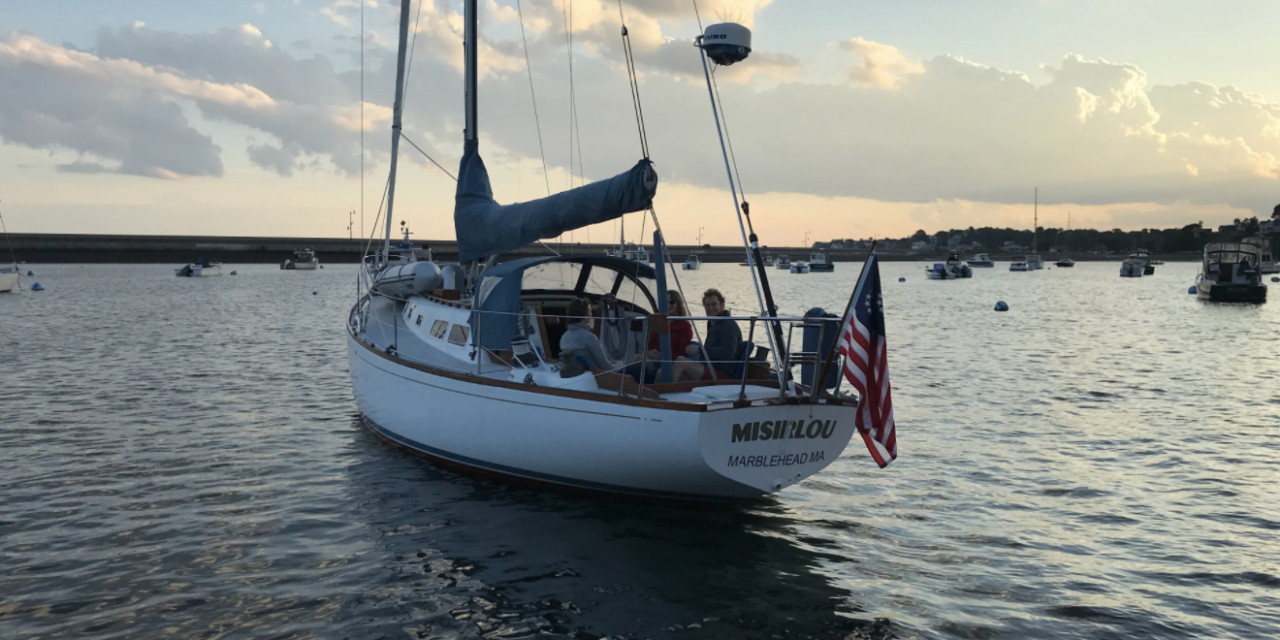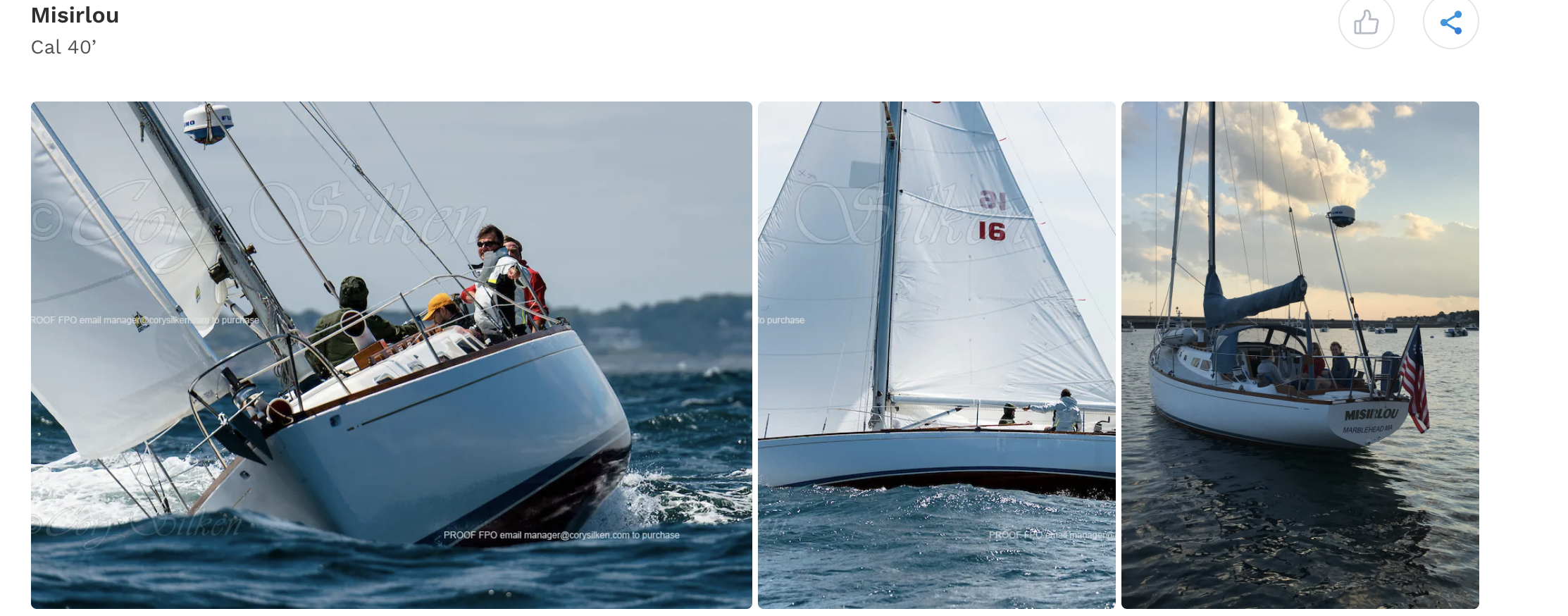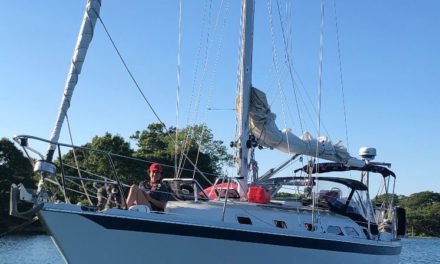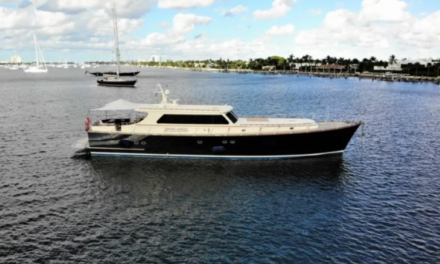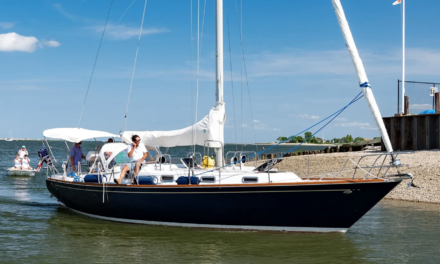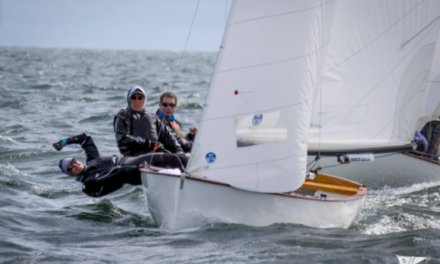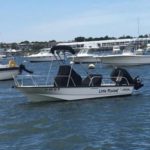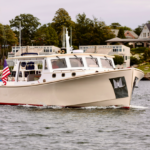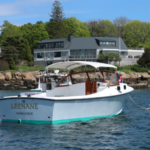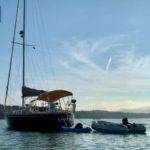“‘Misirlou’ is a middle eastern folk song that was made into a California surf guitar hit by Dick Dale about the time our boat was built. Cal 40s had a reputation as the first ocean racing boat that could “surf” down wind… So, California. Surf. 1964. Great song. It all seemed to fit!“
Misirlou, CAL 40′
Interview with the Captain — Tom Egan
About Cruising
Where have you sailed to, and what was your longest trip?
Other than a Bermuda delivery and a Leeward Islands trip from Guadeloupe to Granada in OPBs (other peoples’ boats) I’m mostly a coastal sailor. In our own boat we have cruised between Nantucket and Roque Island Maine, about 20 miles from the Canadian border. We have gone somewhere, mostly to Maine, every summer for 30 years, EXCEPT 2020 when Covid meant we couldn’t safely have a delivery crew.
Could you share a memorable story from your sailing adventures?
I guess the most memorable family cruise was chartering in the Vava’u group in Tonga shortly after the Moorings opened their base there in the early 1990s. My daughter was 5 and my son was 1. The charts were based on surveys from the 1800s and were wildly inaccurate, but the sailing was great, the scuba diving was the best we’ve ever experienced anywhere, and the people were amazing. We were invited to a Tongan feast with traditional Polynesian singing and dancing that still brings a tear to my eye.
Swarms of giant fruit bats at dusk and on our last day we were treated to an incredible bioluminescent light show of some kind of sea worms spinning bright blue circles in the water all around the boat. Very otherworldly to this New England boy.
Most under-rated piece of equipment for long-range cruising?
The good ol’ hand bearing compass can’t be beat for coastal cruising. Sure, the GPS tells you where you are, but the HBC tells you when to tack and if that tanker is on a collision course or not.
Do you have any other notable resources you use (apps, devices, etc)?
I’m a bit of a Luddite when it comes to marine electronics. We have rudimentary GPS and radar (both overdue for an upgrade) butI rarely turn them on in the daytime. Someone did, however, show me the neat trick of putting your iPhone camera up to the binocular eyepiece and taking a picture of a distant buoy so you can zoom in and read the number. I use that trick on a regular basis.
About the boat
How did you choose to buy a Cal Sailboat?
Cal 40s have a great reputation and a long history of winning races, right up to present day. Past owners include some impressive names in the sailing world like Ted Turner, Dennis Connor and Stan Honey (who still owns his). There also happened to be a Cal 40 sitting on the mooring next to mine that I had been admiring for years. I told the owner I was considering buying one and could I look around his boat? Before I could finish the sentence he shouted “This one’s for sale!” like I had sprung a trap or something. A week later I owned a Cal 40.
What other kinds of boats did you consider before buying this model (and how did they compare)?
I wanted something with classic lines, about 40 feet, cruisable, but higher performance than our old Bristol 35. My “Boat Decision Matrix” spreadsheet (yes, I’m an engineer) included boats like J-40, J-42, Hinckley B-40, Cambria 40, Bristol 40, older Nautor Swans, Baltics and a few older customs and one-offs I came across in my research. The Cal 40 offered by far the most bang for the buck.
Who first introduced you to sailing? Growing up in Marblehead, my parents raced Lightnings, so I’ve been around sailing my whole life. (My mom liked to tell a story about capsizing in a squall when I was in utero.) I went to Pleon, and sailing started to get really interesting when my friends were doing it, not just my parents.
What boats have you previously owned?
My first boat was, a “Tumlaren”, a 27 foot wooden, Swedish, double-ended, needle-like, 20-square- meter designed by Knud Reimers named Zara. I bought her in Ventura CA when I was living and working in Los Angeles. I later moved her up to San Francisco and finally back to Marblehead when Mary and I moved back here in 1985. Zara pointed closer to the wind than anything at the time and was beautiful to look at, but was a tad cramped in the cockpit and had no accommodations below. When my daughter was born we decided to upgrade to a cruising boat (fiberglass this time, I had paid my wooden boat dues) so we bought Brigadoon, the afore mentioned 1966 Bristol 35 designed by John Alden (not to be confused with the newer 35.5 designed by Dieter Empacher). Brigadoon served us well for 10 years of family day sailing and cruising.
What are the features you like most about your boat?
The first thing everyone notices when they step aboard Misirlou is the tiller instead of a wheel. Rather unusual for a 40 foot boat. I absolutely love the tiller because you can feel every imperfection in the sail trim through your fingertips. The Cal 40 is one of the first production boats to have a fin keel and spade rudder, a design considered radical in its day. The original spade rudder was poorly balanced and was a bear to handle on a heavy weather reach. A year after I bought Misirlou, the Cal 40 Owners Association
commissioned a new rudder design from Carl Schumacher and did a group buy of 20 rudders at cost. The result is a rudder you can steer with your pinkie finger in most conditions, quite a feat in a 40 foot boat with a tiller.
What features/improvements have you added or do you plan to add?
I was very lucky that Chuck, my previous owner maintained all the original equipment beautifully and the boat wasn’t “upgraded to death”, meaning hundreds of holes drilled everywhere for hardware upgrades every few years. This allowed us to gradually upgrade hardware and systems over the 20 years we’ve owner Misirlou. The electrical system was one of the first things to upgrade since the Cal 40 effectively “pre-dates electricity”, or at least electrical systems as we now know them. A primitive panel
with 4 fuses for nav lights, cabin lights, the optional analog strobe depth sounder and a spare was all there was when we bought the boat. The interior is pretty much stock except for a new gimbaling stove and a highly over-engineered holding tank system that puts Chernobyl to shame. On deck we have gone one size up on all the standing rigging and replaced the old bronze chainplates with thicker 316 stainless. The big upgrade in 2020 was our beautiful new mast from Ballenger Spars in California. Cal 40s are still raced one-design in some locals, and it was important to me to fit the “class legal” mast option. We had the hull faired and AwlGripped about 15 years ago and it still looks great. The next step is to glass the hull/deck joint (a common Cal 40 upgrade), replace the sketchy toe rail and AwlGrip the deck and cabin house. The overall plan is to keep the boat strong, light and simple.
Do you belong to a yacht club or other boating organizations (and what’s your homeport)?
I grew up in the Shipyard neighborhood of Marblehead, so the Marblehead Yacht Club is as homey as it gets. We love it. I recently joined the Classic Yacht Owners Association. Although we are one of the few “plastic” boats in the fleet, being a 57-year-old boat designed to the CCA rule apparently qualifies us. And, of course, we belong to the Cal 40 owner’s association, a very active and supportive group.
What is the biggest challenge you have in servicing your boat?
Getting old! Cramming my body into the tiny chain locker to tighten chain plate bolts had me rethinking
some life decisions.
Do you have any advice for those looking to buy a Cal Sailboat like yours?
Cal 40s come up for sale on a regular basis. Try to find one that hasn’t been modified too much. The original design is just about perfect, and when owners change the sail plan or underbody design it rarely comes out better. They are very simple boats and everything is accessible and fixable.
What’s the story behind the boat’s name?
“Misirlou” is a middle eastern folk song that was made into a California surf guitar hit by Dick Dale about the time our boat was built. Cal 40s had a reputation as the first ocean racing boat that could “surf” down wind. (Google ‘cal 40 illusion diamond head’ to see Stan Honey’s Illusion surfing across the finish line in a Transpac race.) So, California. Surf. 1964. Great song. It all seemed to fit!
Check it out
Click the gallery below for more photos and information about Misirlou!

